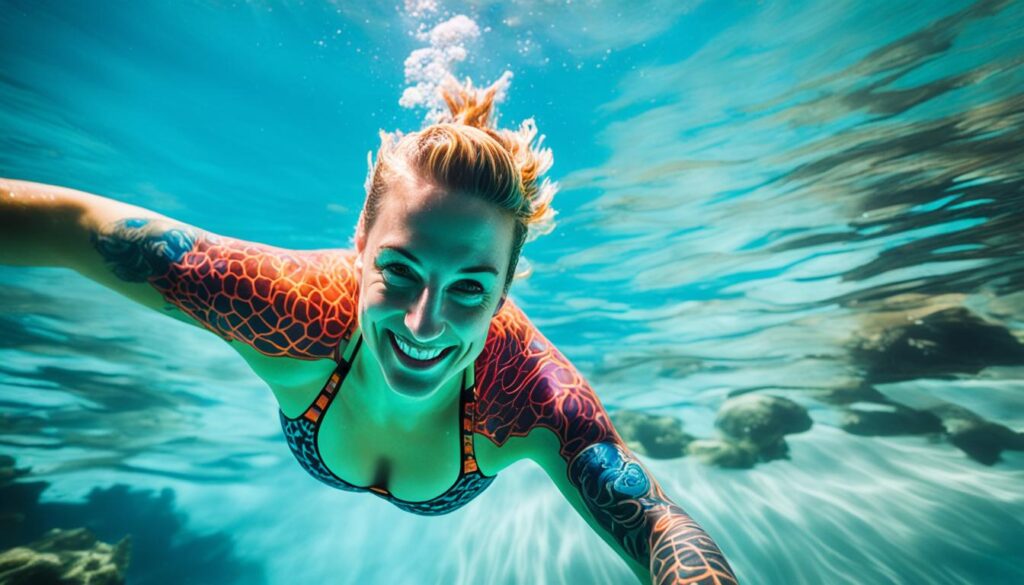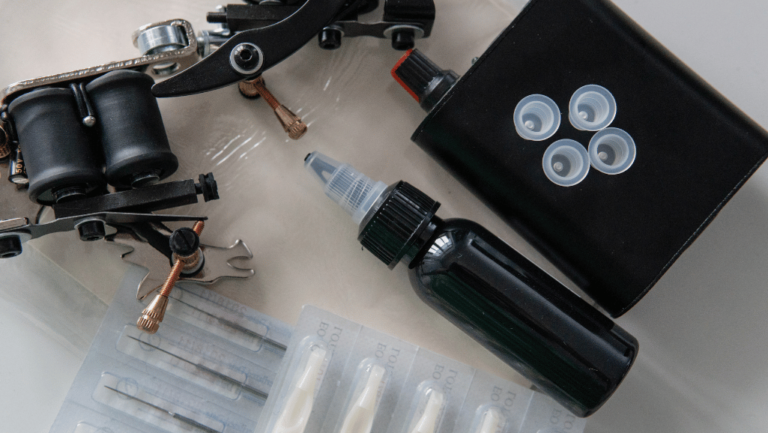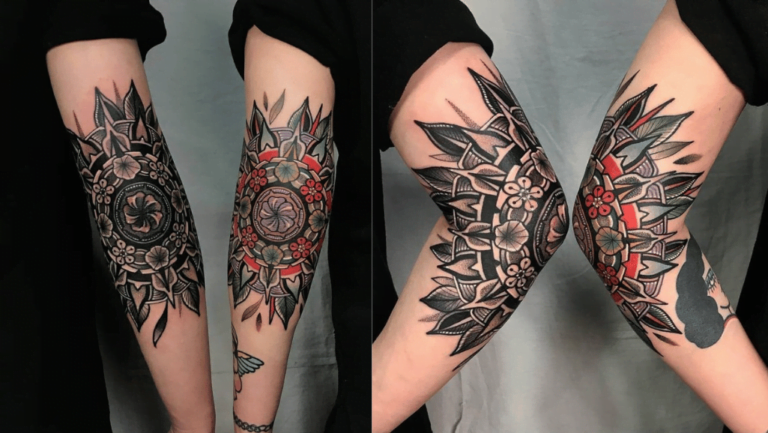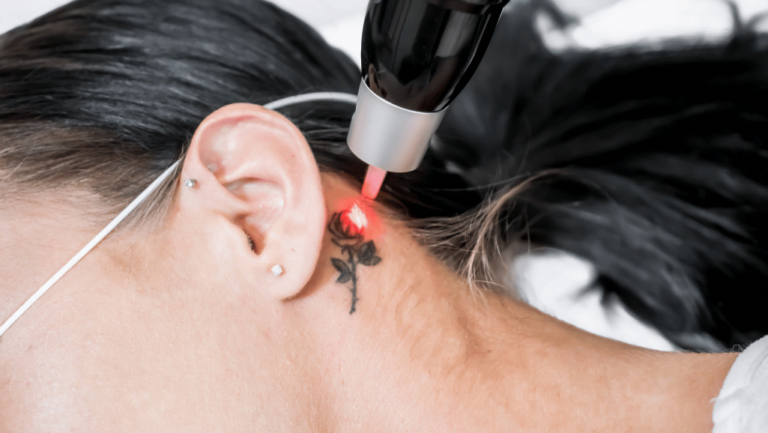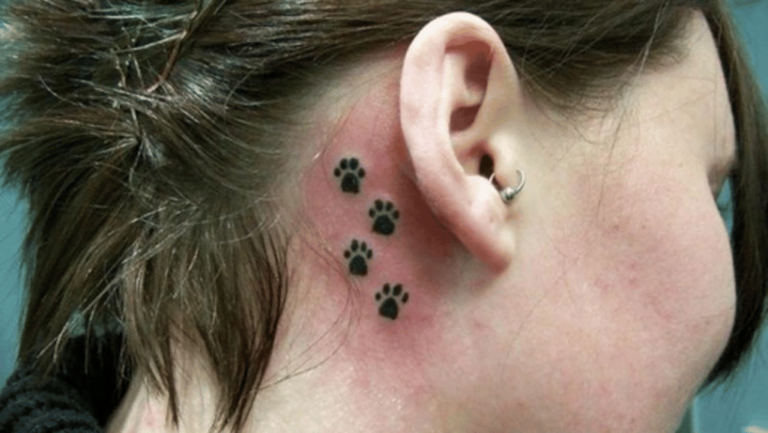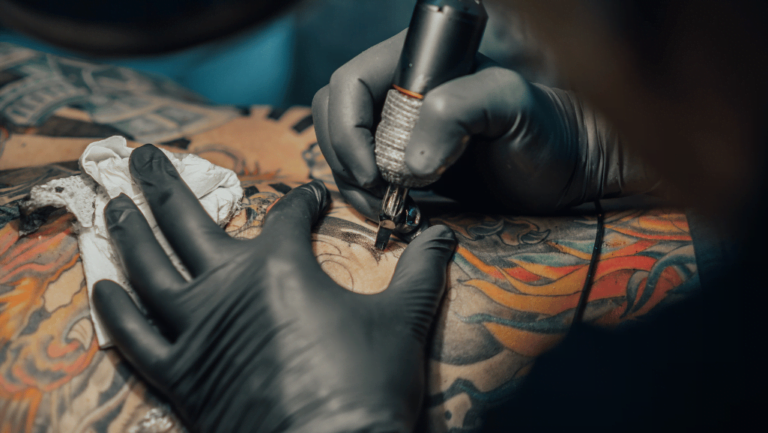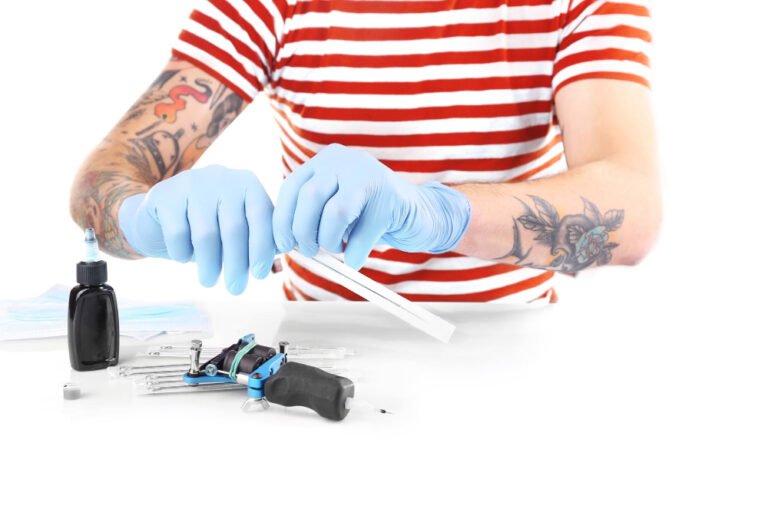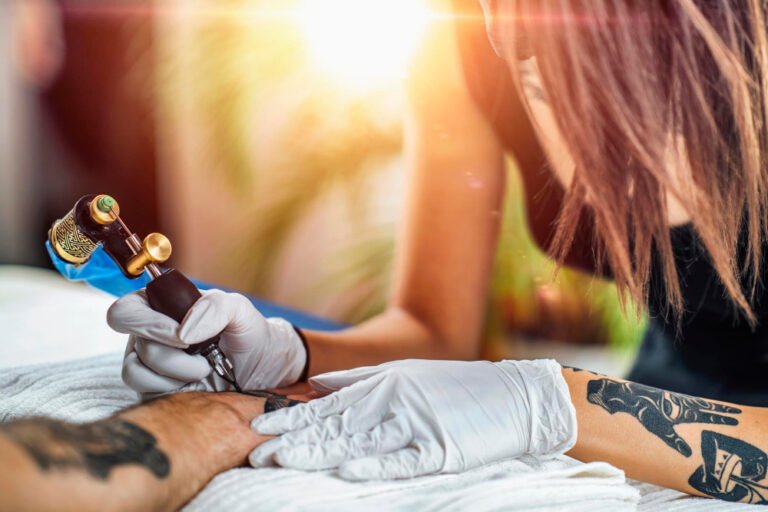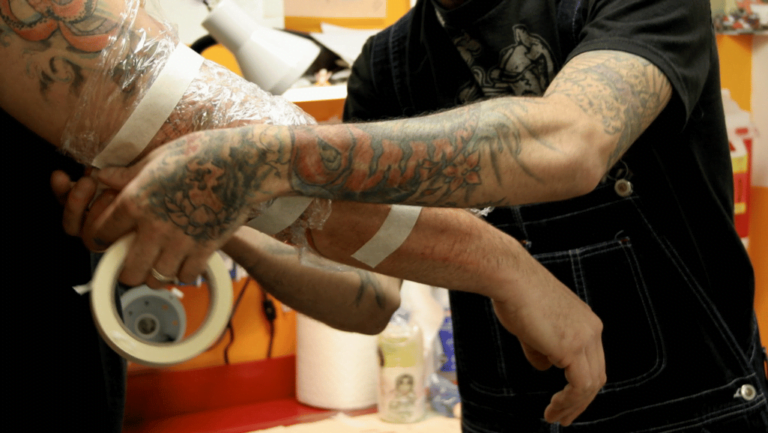Until your tattoo is fully healed, it’s important to avoid swimming to prevent infections and maintain the integrity of the tattoo. Water from pools, lakes, and oceans can introduce bacteria into the healing skin, potentially affecting the color and cosmetic result of your tattoo. The healing time varies depending on the size and location of the tattoo, typically taking two to six weeks to heal completely. It’s crucial to wait until all redness, itching, scabbing, and flaking have resolved before considering swimming. How long after you get a tattoo can you swim?
Key Takeaways:
- Swimming with a new tattoo can increase the risk of infection and affect the healing process.
- Water from pools, lakes, and oceans is not sterile and can introduce bacteria into the healing skin.
- The healing time for a tattoo can range from two to six weeks, depending on various factors.
- It is important to follow proper aftercare instructions and ensure the tattoo has fully healed before swimming.
- If swimming is necessary before the tattoo is fully healed, use waterproof bandages and follow specific guidelines.
The Risks of Swimming with a New Tattoo
Swimming with a fresh tattoo can lead to various risks. Water from pools, lakes, and oceans is not sterile and can introduce bacteria into the healing skin, increasing the risk of infection. The salt and chemicals in pools can also irritate the skin and cause discomfort or even pull ink from the tattoo. Swimming can affect the healing process and result in increased fading or discoloration of the tattoo. It’s essential to give your tattoo time to heal properly and avoid swimming until it has fully healed.
| Risks of Swimming with a New Tattoo | Effects |
|---|---|
| Introduction of bacteria | Increased risk of infection |
| Irritation from salt and pool chemicals | Discomfort and potential ink loss |
| Affected healing process | Increased fading or discoloration |
Introduction of Bacteria
Water from pools, lakes, and oceans is not sterile and can introduce bacteria into the healing skin. This can lead to infections that can be difficult to treat and may require medical intervention.
Irritation from Salt and Pool Chemicals
The salt and chemicals present in pools can irritate the healing skin, causing discomfort and potentially pulling ink from the tattoo. This can affect the overall appearance and quality of the tattoo.
Affected Healing Process
Swimming can disrupt the healing process of a fresh tattoo, leading to increased fading or discoloration. It’s important to allow the tattoo to fully heal before exposing it to water.
How Long Before You Can Safely Swim
The healing time for a tattoo can vary from person to person, but tattoo artists generally recommend waiting two to four weeks before going swimming. During this time, your tattoo will go through the healing process, forming scabs and gradually shedding them as a new layer of skin develops. It’s important to allow this process to complete before exposing your tattoo to swimming pools or other bodies of water.
When your tattoo has fully healed, it will no longer show any signs of redness, itching, scabbing, or flaking. At this point, it is safe to go swimming without compromising the integrity of your tattoo. Following proper aftercare instructions, such as keeping the tattooed area clean and dry, will help ensure that your tattoo heals properly and is ready for swimming.
Please remember that every individual may experience a slightly different healing timeline, so it’s essential to consult with your tattoo artist for personalized guidance on when it is safe for you to go swimming after getting a tattoo.
Tattoo Healing Timeline
| Weeks | Healing Stage |
|---|---|
| Week 1 | Formation of scabs and initial shedding of dead skin |
| Weeks 2-3 | Continued shedding of scabs and development of new skin |
| Week 4 | Complete healing of the tattooed area with no signs of redness, itching, scabbing, or flaking |
It’s important to note that swimming before your tattoo has fully healed can increase the risk of infection and affect the color and cosmetic result of the tattoo. Therefore, it’s advisable to err on the side of caution and wait until your tattoo is completely healed before enjoying a dip in the pool.
Remember, patience is key when it comes to the healing process of your tattoo. Taking proper care of your tattoo during the healing period and following your artist’s advice will help ensure that you can safely enjoy swimming without any negative effects on your tattoo.
Guidelines for Swimming with a New Tattoo
If it’s not possible to wait until the tattoo is fully healed before swimming, there are some guidelines to follow. First, apply a waterproof bandage like Saniderm to cover the tattoo while in the water. Limit the time spent in the water with the dressing on as much as possible. After swimming, immediately dry the skin, remove the bandage, and gently wash the area with soap and water. It’s important to resume normal wound care after patting it dry. Avoid applying sunscreen directly to the new tattoo during the healing phase and protect it from sun exposure with protective clothing or a bandage. Once the skin has fully healed, use sunscreen daily to prevent tattoo pigment fading.
Here are some important guidelines to follow when swimming with a fresh tattoo:
- Apply a waterproof bandage, such as Saniderm, before swimming to protect the tattoo.
- Limit the time spent in the water with the dressing on to minimize exposure to water.
- After swimming, immediately dry the skin and remove the bandage.
- Gently wash the tattooed area with soap and water to cleanse any residual bacteria.
- Pat the area dry and resume normal wound care to promote proper healing.
- Avoid applying sunscreen directly to the new tattoo during the healing phase.
- Protect the tattoo from sun exposure with clothing or a bandage.
- Once the tattoo has fully healed, use sunscreen daily to prevent color fading.
Following these guidelines will help minimize the risks associated with swimming with a fresh tattoo and promote the proper healing process. It’s essential to prioritize the care and protection of your tattoo to ensure its long-lasting beauty.
Can You Waterproof a Tattoo for Swimming?
While it’s not possible to fully waterproof a tattoo, there are some methods that swimmers have tried to provide some protection while swimming. These include:
- Using waterproof bandages that fully wrap and cover the tattoo
- Applying a heavy layer of Vaseline
- Using plastic press n’ seal wrap
It’s important to note that these methods are not foolproof, and a new tattoo is still in the healing process and requires proper care. After swimming, it’s crucial to remove the covers and take the following steps:
- Gently wash the tattoo with warm water and antibacterial soap
- Let it air dry
- Apply aftercare cream or ointment as recommended by your tattoo artist
Proper aftercare is essential for the healing and preservation of your new tattoo. While these methods may offer temporary protection while swimming, it’s always best to wait until your tattoo is fully healed before taking a dip.
Other Considerations for Swimming with a New Tattoo
While swimming with a fresh tattoo should be avoided, there are some other considerations to keep in mind. Here are a few tips to help you take care of your tattoo and enjoy swimming:
1. Showers are Fine
It’s important to avoid submerging the tattooed area in water, especially in swimming pools, lakes, or oceans. However, showers are perfectly fine and recommended to keep your tattoo clean. Use lukewarm water and a mild, fragrance-free soap to gently cleanse the tattooed area. Be careful not to scrub or irritate the tattoo during the process.
2. Dry Thoroughly
After showering or any contact with water, it’s essential to dry off the tattoo completely. Pat the tattooed area gently with a clean, soft towel until it’s completely dry. By drying the tattoo thoroughly, you prevent moisture from being trapped, which could hinder the healing process.
3. Continue Proper Aftercare
Even if you’re eager to get back in the water, it’s crucial to continue practicing proper aftercare for your tattoo. This includes avoiding excessive exposure to the sun, wearing protective clothing, and using non-comedogenic moisturizing formulations with mineral sunscreen ingredients to protect the tattooed area from harmful UV rays.
4. Stay Hydrated
Swimming in pools or spending time in the sun and water can dehydrate your body, which can indirectly affect your tattoo’s healing process. Make sure to drink plenty of water and stay hydrated before and after swimming to support your body’s natural healing abilities.
5. Consult with Your Tattoo Artist
Each tattoo artist may have specific guidelines and recommendations based on their expertise and the size, location, and intricacy of your tattoo. It’s always best to consult with your tattoo artist directly for personalized advice on swimming with a new tattoo.
Following these considerations will help protect your tattoo and ensure it heals properly. Remember, the care you provide during the healing process will contribute to the long-lasting beauty and vibrancy of your tattoo.
Conclusion
Swimming with a new tattoo is not recommended until it has fully healed. It’s important to prioritize the healing process to ensure the long-lasting beauty of your tattoo. The healing time typically varies from two to four weeks. During this time, swimming can introduce bacteria and chemicals into the healing skin, increasing the risk of infection and affecting the tattoo’s color and cosmetic result.
If swimming is unavoidable, follow guidelines such as using a waterproof bandage to protect the tattoo, keeping the tattooed area dry after swimming, and practicing proper aftercare. But remember, these measures are not foolproof and cannot fully waterproof the tattoo. It’s crucial to continue following proper aftercare instructions and avoid exposing the tattoo to excessive moisture or direct sunlight.
By giving your tattoo enough time to heal and taking care of it properly, you can enjoy swimming without compromising the integrity of your tattoo. Remember to consult with your tattoo artist for personalized aftercare instructions and follow them diligently. Prioritizing your tattoo’s healing process will ensure that you can enjoy the water while maintaining the long-term beauty of your artwork.
FAQ
How long after you get a tattoo can you swim?
What are the risks of swimming with a new tattoo?
How long before you can safely swim after getting a tattoo?
What are the guidelines for swimming with a new tattoo?
Can you waterproof a tattoo for swimming?
What are other considerations for swimming with a new tattoo?
Can I swim in a pool with a new tattoo?
Forhad
Forhad's writing is not just about the artistry of tattoos or the latest trends in the industry; it's an exploration of the deep-rooted connections people have with their tattoos, reflecting personal narratives, cultural histories, and moments of transformation. Through a mix of in-depth features, personal narratives, and insightful analyses, he sheds light on the multifaceted nature of tattooing, revealing the emotional and cultural layers that lie beneath the surface.




